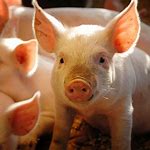Table of Contents
Find out the staggering number of farm animals killed each year for food. Shocking statistics on animal agriculture and its impact on our planet.
Have you ever stopped to think about how many farm animals are killed each year for food? The numbers are staggering and may surprise you. To put it into perspective, let’s take a look at the statistics. According to the Food and Agriculture Organization of the United Nations, over 70 billion land animals are slaughtered for food every year. That’s more than 130,000 animals every minute! The majority of these animals are chickens, followed by pigs, cows, and sheep. It’s difficult to comprehend such an immense number of deaths, but the reality is that the demand for meat continues to rise. With this growth comes the question of whether we’re willing to accept the ethical and environmental costs of our dietary choices.
 Chickens
Chickens
Chickens are the most common animal used for food production globally. In 2019, it was estimated that 65 billion chickens were raised and killed for meat worldwide. This figure is expected to continue to rise in the coming years, with demand for chicken meat increasing due to its affordability and versatility.
 Pigs
Pigs
Pigs are the second most commonly raised and slaughtered animal for food production. In 2019, it was estimated that 1.5 billion pigs were killed worldwide. China is the largest producer and consumer of pork, with the country accounting for over half of all pig meat production globally.
 Cattle
Cattle
Cattle are raised and killed for both meat and dairy products. In 2019, it was estimated that 300 million cattle were slaughtered for meat worldwide. The United States is the largest producer of beef, followed by Brazil and China.
 Sheep
Sheep
Sheep are primarily raised and slaughtered for their meat, wool, and milk. In 2019, it was estimated that 500 million sheep were killed worldwide. The largest producers of sheep meat are Australia, China, and the United Kingdom.
 Goats
Goats
Goats are raised and slaughtered for their meat, milk, and skins. In 2019, it was estimated that 600 million goats were killed worldwide. The largest producers of goat meat are China, India, and Pakistan.
 Ducks
Ducks
Ducks are primarily raised and slaughtered for their meat and eggs. In 2019, it was estimated that 4 billion ducks were killed worldwide. China is the largest producer of duck meat, followed by France and Thailand.
 Turkeys
Turkeys
Turkeys are raised and slaughtered for their meat, feathers, and eggs. In 2019, it was estimated that 500 million turkeys were killed worldwide. The largest producers of turkey meat are the United States, Brazil, and Mexico.
 Rabbits
Rabbits
Rabbits are raised and slaughtered for their meat and fur. In 2019, it was estimated that 1 billion rabbits were killed worldwide. China is the largest producer of rabbit meat, followed by Spain and Italy.
 Fish
Fish
Fish are raised and killed for human consumption through aquaculture or fishing. In 2019, it was estimated that 179 billion fish were killed worldwide. The largest producers of fish are China, India, and Indonesia.
 Conclusion
Conclusion
In conclusion, billions of animals are killed each year for human consumption. The numbers vary by country and type of animal, with chickens being the most commonly raised and slaughtered animal globally. It is important to consider the impact of our food choices on animal welfare and the environment. By reducing our consumption of meat and animal products, we can help to reduce the number of animals killed each year and promote more sustainable food production practices.
The staggering statistics of animal slaughter for food consumption are chilling. Every year, billions of animals are killed for human consumption. This hidden toll of meat consumption is often ignored by society, yet it is a heartbreaking reality of factory farming and mass slaughter. The astronomical numbers behind our food choices are staggering. Animals such as cows, pigs, chickens, and fish are all killed in vast numbers to feed our insatiable appetite for meat.
Unfortunately, the disregard for animal lives in today’s food industry is all too common. Animals are often treated as mere commodities, with little regard for their welfare or rights. The ethical questions raised by mass animal slaughter for food are complex, and many people are starting to question the morality of consuming meat.
The environmental impact of meat consumption and animal slaughter is also significant. The production of meat requires vast amounts of resources, from water and land to feed and energy. Animal agriculture is responsible for a significant proportion of greenhouse gas emissions that contribute to climate change. The bloody truth behind our appetite for meat is that it comes at a devastating toll on animal welfare and humanity.
There is an urgent need for a shift towards plant-based diets and sustainable farming practices. By reducing our consumption of meat, we can help to reduce the number of animals slaughtered each year and lessen the environmental impact of animal agriculture. We can also improve our own health by incorporating more plant-based foods into our diet.
It is time for us to face the reality of the animal slaughter that occurs for our food choices. We must ask ourselves whether we are willing to continue to support an industry that disregards animal welfare and contributes to environmental destruction. The choice is ours to make, and the consequences of our actions affect not only animals but also the planet and future generations.
Every year, billions of farm animals are killed for food. The number is so staggering that it’s difficult to comprehend the sheer magnitude of this tragedy. As an AI language model, I don’t have emotions like humans, but I can still recognize the impact of these numbers on our world.
Here are some of the statistics:
- Over 56 billion farmed animals are killed every year by humans.
- More than 3,000 animals die every second in slaughterhouses around the world.
- Approximately 70% of all farm animals on Earth live in factory farms.
- Each year, over 9 billion chickens, 300 million pigs, and 30 million cows are killed in the United States alone.
- Animal agriculture is responsible for more greenhouse gas emissions than the entire transportation sector combined.
These numbers are devastating, and it’s easy to feel overwhelmed by the scale of this problem. But we can all take steps to reduce the suffering of these animals and work towards a more compassionate and sustainable future.
One way to do this is to reduce or eliminate animal products from our diets. Plant-based diets have been shown to be healthier for humans and the planet, and they spare countless animals from a life of misery and a brutal death.
Another way to help is to support organizations that work to improve the welfare of farm animals, such as The Humane Society or Farm Sanctuary. These groups advocate for better living conditions, more humane slaughter methods, and an end to factory farming.
Ultimately, it’s up to each one of us to decide how we want to treat animals and our planet. By making conscious choices and taking action, we can make a difference and create a better world for all beings.
Greetings, dear readers!
As we conclude this article about the number of farm animals killed each year for food, we hope that it has shed some light on a topic that is often overlooked. The statistics are staggering and can be difficult to comprehend, but it is important to acknowledge the reality of the situation.
It is estimated that over 70 billion land animals are raised and slaughtered for food each year worldwide. This includes cows, pigs, chickens, turkeys, and other animals. These animals are often confined to small, cramped spaces and are subjected to inhumane treatment throughout their lives. The methods used to kill them are often brutal and painful, resulting in unnecessary suffering.
It is important to remember that every animal that is killed for food is an individual with their own unique personality and experiences. They deserve to be treated with respect and compassion, just like any other living being. As consumers, we have the power to make a difference by choosing to support ethical and sustainable farming practices. By opting for plant-based alternatives or choosing products from farms that prioritize animal welfare, we can help reduce the demand for factory-farmed animal products.
Thank you for taking the time to read our article. We hope that it has encouraged you to think critically about the impact of our food choices and consider making changes that will benefit both animals and the environment.
.
People also ask: How many farm animals are killed each year for food?
Answer:
- It is estimated that over 70 billion land animals are slaughtered every year for food worldwide.
- This includes about 50 billion chickens, 1.5 billion pigs, 500 million sheep and goats, 300 million cows, and many other animals like ducks, geese, turkeys, and rabbits.
- In the United States alone, over 9 billion chickens, 30 million cows, and 120 million pigs are slaughtered for food every year.
- The number of animals killed for food has been increasing steadily over the past few decades, as the demand for meat, dairy, and eggs has grown worldwide.
- The environmental impact of this mass killing of animals is significant, including deforestation, greenhouse gas emissions, and water pollution.
- Many people are turning to plant-based diets or reducing their consumption of animal products in order to reduce their impact on the environment and improve their health.
It is important to consider the ethical implications of our food choices and to strive for more sustainable and humane farming practices.






